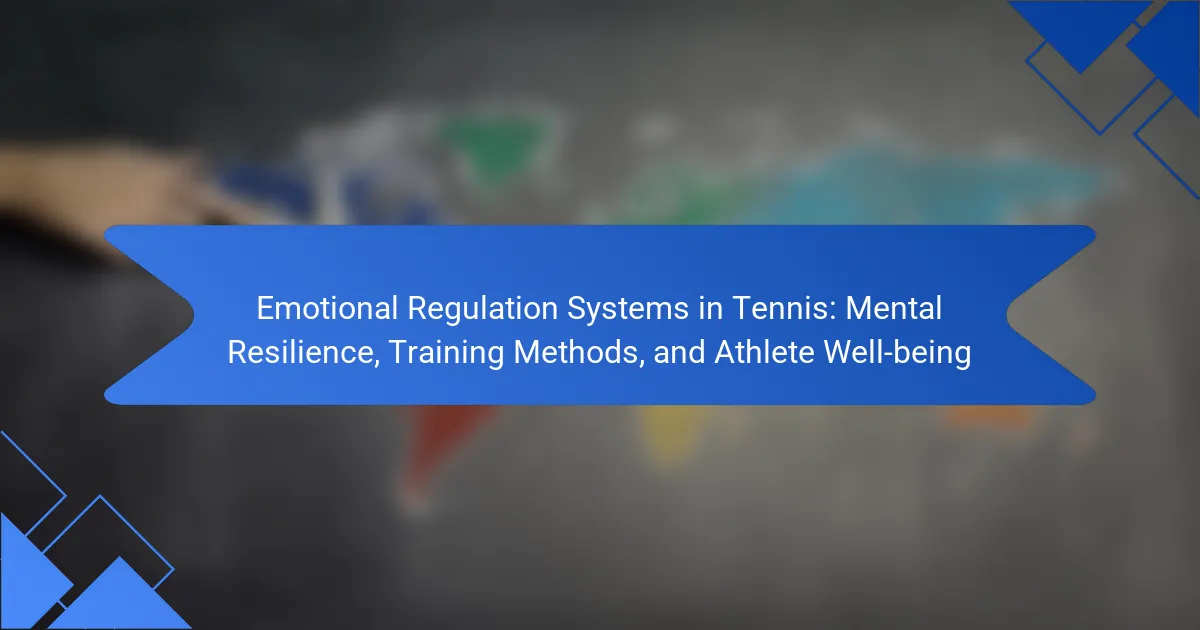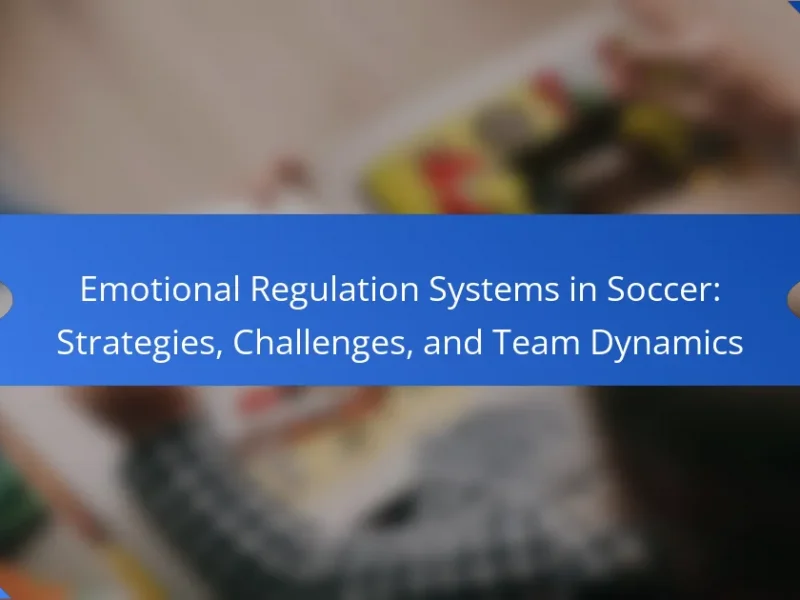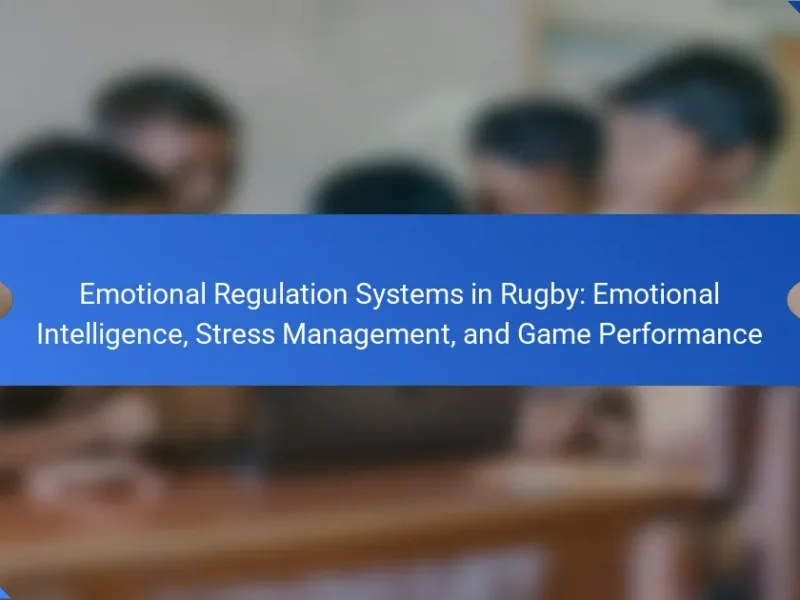Emotional regulation systems in tennis are essential for enhancing mental resilience and athlete well-being. This article explores effective training methods, including mindfulness techniques and cognitive restructuring, to improve focus and reduce anxiety. It also examines the unique and rare attributes that influence emotional regulation, such as personalized coping strategies and social support systems. Finally, the importance of consistent practice and reflective strategies in developing emotional regulation skills will be discussed.
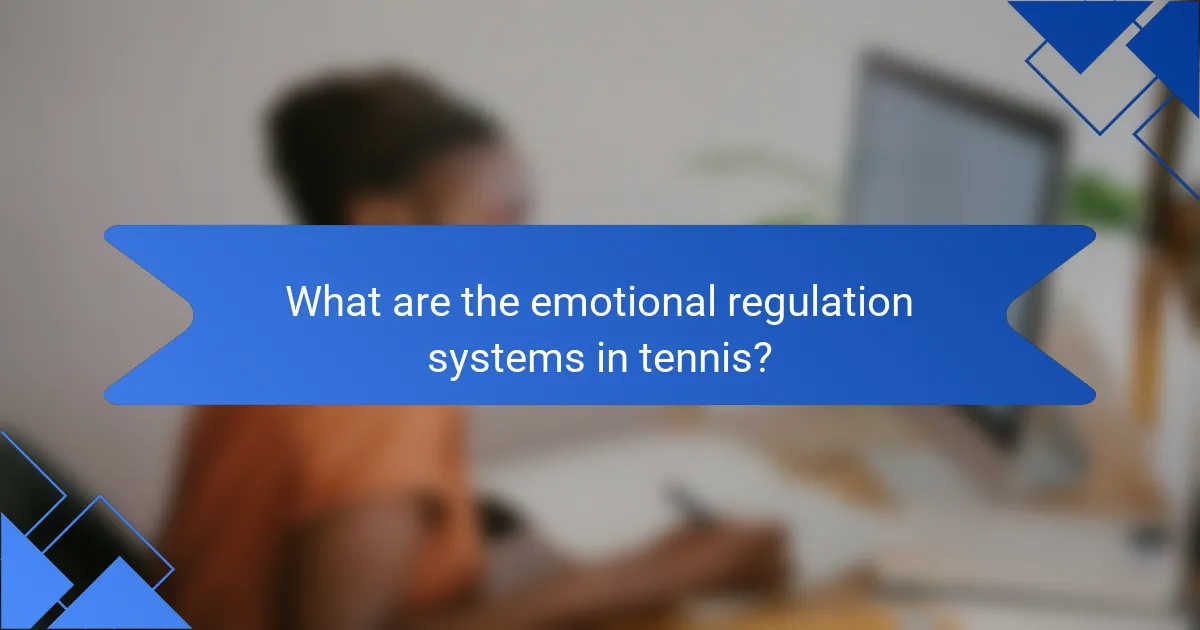
What are the emotional regulation systems in tennis?
Emotional regulation systems in tennis involve strategies to manage emotions, enhancing mental resilience and athlete well-being. Key methods include mindfulness training, cognitive restructuring, and visualization techniques. These approaches help players maintain focus, reduce anxiety, and improve performance under pressure. For instance, studies show that athletes utilizing mindfulness experience a 20% increase in concentration levels during matches. Additionally, integrating emotional regulation into training routines fosters a supportive environment, promoting overall mental health.
How do emotional regulation systems impact mental resilience?
Emotional regulation systems significantly enhance mental resilience in athletes by enabling effective stress management. These systems help players maintain focus during high-pressure situations, fostering a positive mindset. Training methods that incorporate emotional regulation strategies, such as mindfulness and cognitive restructuring, improve overall athlete well-being. As a result, athletes develop unique coping mechanisms that differentiate them in competitive environments.
What training methods enhance emotional regulation in athletes?
Training methods that enhance emotional regulation in athletes include mindfulness practices, cognitive-behavioral techniques, and visualization strategies. Mindfulness training helps athletes stay present, reducing anxiety and improving focus. Cognitive-behavioral techniques assist in identifying and reframing negative thoughts, promoting a positive mindset. Visualization strategies allow athletes to mentally rehearse performance scenarios, enhancing confidence and emotional control. These methods collectively foster mental resilience, crucial for athlete well-being and performance consistency.
Which techniques are most effective for emotional regulation?
Mindfulness, cognitive restructuring, and breathing techniques are effective for emotional regulation in tennis. These strategies enhance mental resilience and promote athlete well-being. Mindfulness helps players stay present, reducing anxiety. Cognitive restructuring allows athletes to reframe negative thoughts, fostering a positive mindset. Breathing techniques regulate physiological responses, aiding focus and composure during matches.
How can visualization aid in emotional control?
Visualization significantly enhances emotional control in tennis by helping athletes manage stress and focus. By mentally rehearsing scenarios, players can reduce anxiety and improve performance under pressure. Visualization techniques foster a sense of calm, allowing athletes to maintain composure during critical moments. This practice not only strengthens mental resilience but also supports overall athlete well-being by promoting a positive mindset.
What is the relationship between emotional regulation and athlete well-being?
Emotional regulation significantly enhances athlete well-being by fostering mental resilience. Effective emotional control helps athletes manage stress, maintain focus, and recover from setbacks. Research indicates that athletes with strong emotional regulation skills report higher levels of satisfaction and performance. Training methods that integrate emotional awareness and coping strategies can improve overall mental health and athletic success.
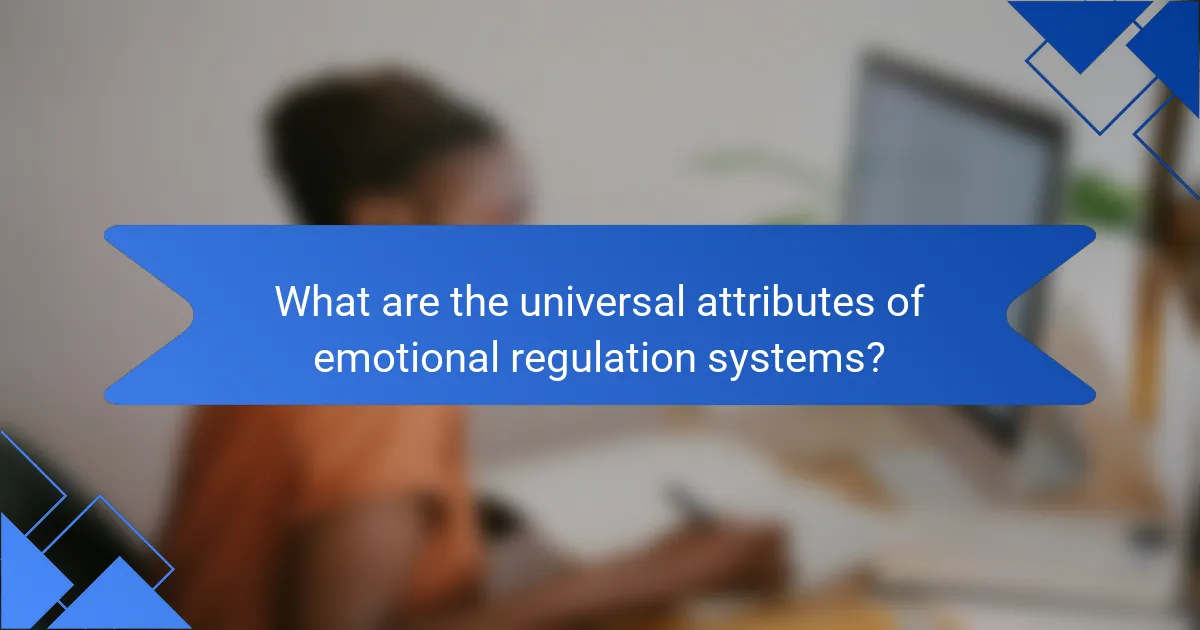
What are the universal attributes of emotional regulation systems?
Emotional regulation systems universally share attributes such as awareness, understanding, and management of emotions. These systems enhance mental resilience, crucial for athletes in tennis. Effective training methods focus on developing emotional intelligence and coping strategies, promoting overall athlete well-being.
How does emotional awareness contribute to performance?
Emotional awareness significantly enhances performance by enabling athletes to manage stress and maintain focus. This regulation fosters mental resilience, essential for overcoming challenges in tennis. Recognizing emotions allows players to adapt strategies during matches, improving decision-making and overall well-being. Studies indicate that athletes with high emotional awareness exhibit better performance metrics and lower anxiety levels, leading to consistent results on the court.
What role does self-talk play in emotional regulation?
Self-talk significantly enhances emotional regulation in tennis by promoting mental resilience. Athletes use positive self-talk to manage stress and maintain focus during competition. This technique helps in reframing negative thoughts, which can lead to improved performance and well-being. Research indicates that consistent self-talk practice correlates with higher emotional stability, allowing athletes to cope effectively with pressure.
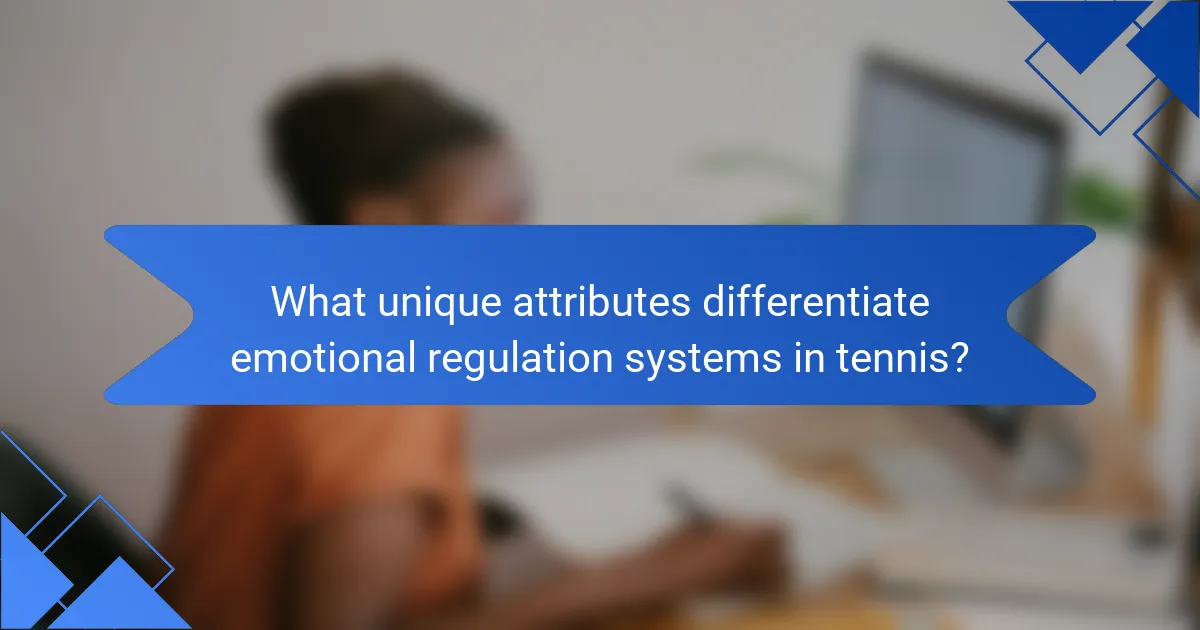
What unique attributes differentiate emotional regulation systems in tennis?
Unique attributes that differentiate emotional regulation systems in tennis include personalized coping strategies, adaptive emotional responses, and the integration of mindfulness techniques. Personalized coping strategies enable athletes to manage stress effectively during matches. Adaptive emotional responses allow players to maintain focus despite pressure, enhancing performance. Mindfulness techniques, such as visualization, support emotional balance and improve mental resilience. These attributes collectively promote athlete well-being and performance consistency in high-stakes environments.
How do elite athletes utilize emotional regulation differently?
Elite athletes utilize emotional regulation through tailored mental resilience strategies, emphasizing training methods that enhance athlete well-being. They often employ techniques such as mindfulness, visualization, and cognitive restructuring to manage stress and maintain focus during competition. This approach allows them to recover quickly from setbacks, maintaining performance under pressure. Unique attributes include personalized mental training regimens that differ across sports, reflecting the specific demands of tennis. As a result, elite tennis players develop a distinct emotional resilience that supports both their competitive edge and overall mental health.
What personal experiences shape an athlete’s emotional regulation style?
Personal experiences significantly influence an athlete’s emotional regulation style. Factors such as early exposure to competitive sports, coaching methods, and personal setbacks shape mental resilience. For instance, athletes who face adversity often develop stronger coping mechanisms. Training methods that emphasize mindfulness and psychological skills enhance emotional control. Additionally, social support from teammates and family plays a crucial role in fostering well-being and emotional stability.
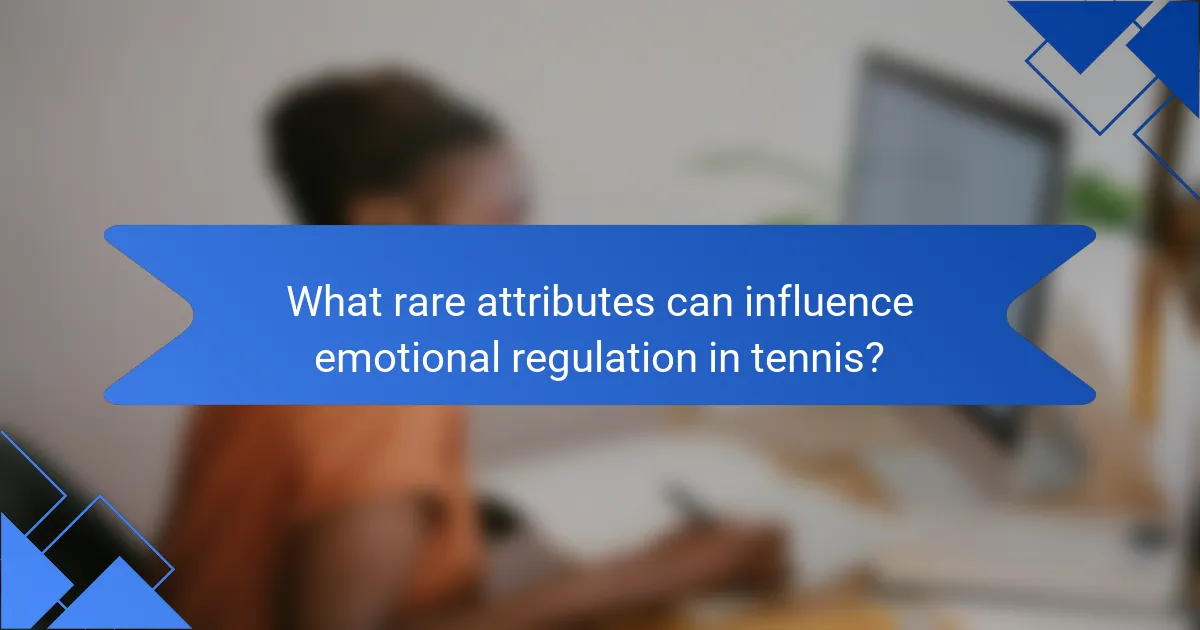
What rare attributes can influence emotional regulation in tennis?
Rare attributes influencing emotional regulation in tennis include unique psychological resilience factors, such as individual coping strategies, social support systems, and past traumatic experiences. These traits can significantly affect an athlete’s ability to manage stress and maintain focus during competitions. For example, a player’s history of overcoming adversity may enhance their mental toughness. Additionally, the presence of a strong mentorship relationship can provide emotional stability, allowing athletes to navigate high-pressure situations more effectively.
How do cultural backgrounds affect emotional responses in players?
Cultural backgrounds significantly influence emotional responses in players by shaping their perceptions and coping mechanisms. For instance, players from collectivist cultures may prioritize team harmony, affecting their emotional regulation during competitions. In contrast, individualistic cultures often emphasize personal achievement, which can lead to heightened emotional responses under pressure. Understanding these differences helps coaches tailor training methods to enhance mental resilience and athlete well-being.
What unique challenges do different age groups face in emotional regulation?
Different age groups face unique challenges in emotional regulation due to varying life experiences and developmental stages. Children often struggle with impulse control and understanding complex emotions. Adolescents may experience heightened emotional responses and peer pressure, complicating their regulation efforts. Adults typically deal with stress from work and family responsibilities, while older adults may face emotional challenges related to health and loss. Tailoring emotional regulation strategies to these age-specific needs enhances mental resilience in athletes.
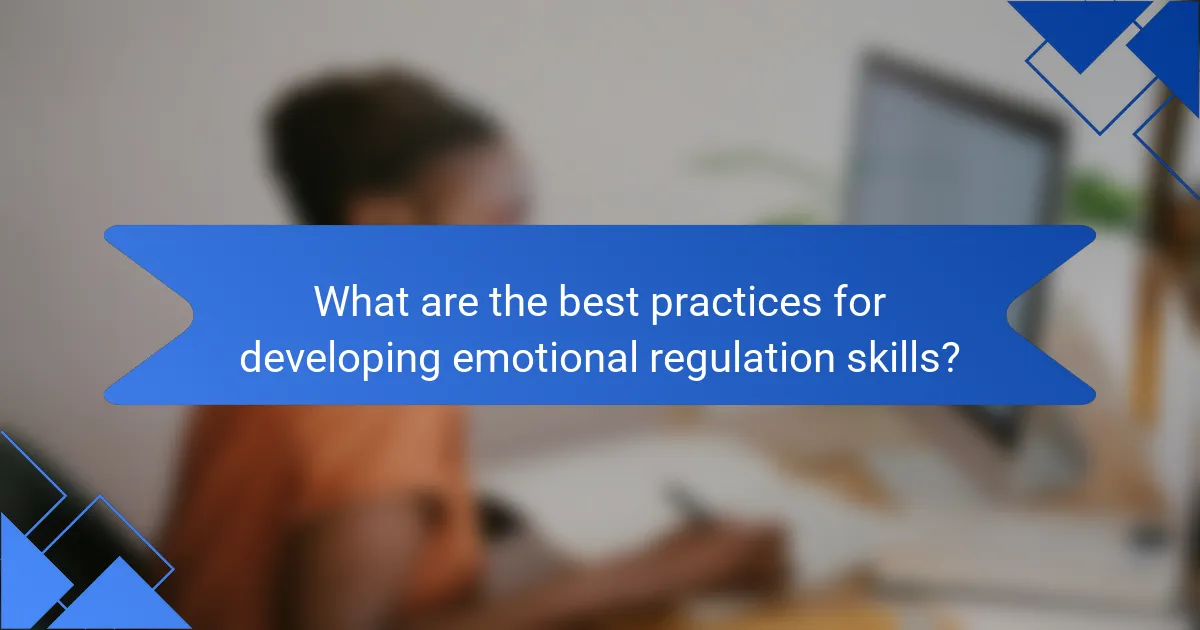
What are the best practices for developing emotional regulation skills?
Developing emotional regulation skills in tennis involves consistent practice and mental strategies. Focus on mindfulness techniques, such as deep breathing and visualization, to enhance self-awareness and manage stress. Implementing cognitive restructuring can help athletes reframe negative thoughts, fostering resilience during competition. Regularly engaging in reflective practices, like journaling, allows players to assess their emotional responses and track progress. Additionally, seeking social support from coaches and teammates can strengthen emotional well-being, creating a positive training environment.
How can coaches support athletes in emotional regulation?
Coaches can support athletes in emotional regulation by implementing tailored mental resilience training, fostering a supportive environment, and teaching coping strategies. These methods enhance athlete well-being and performance.
Effective emotional regulation systems in tennis include mindfulness techniques, visualization practices, and routine development. For example, encouraging athletes to practice deep breathing during high-pressure situations can significantly reduce anxiety levels.
Additionally, coaches should regularly check in with athletes to understand their emotional states, providing feedback and guidance when necessary. This ongoing communication builds trust and allows for personalized strategies that address unique emotional challenges.
Incorporating team-building activities can also strengthen relationships among athletes, promoting a sense of belonging and emotional safety. As a result, athletes are more likely to express their feelings and seek support when needed.
What common mistakes do athletes make in managing emotions?
Athletes often struggle with emotional regulation, leading to common mistakes. These include ignoring emotions, which can result in heightened stress, and failing to develop coping strategies, impacting performance. Additionally, athletes may avoid seeking support, leading to isolation. Overemphasis on perfection can create unnecessary pressure, while neglecting self-reflection can hinder growth. Addressing these issues is crucial for mental resilience and overall well-being in sports.
What strategies can athletes implement for immediate emotional improvement?
Athletes can implement strategies such as mindfulness, visualization, and controlled breathing for immediate emotional improvement. Mindfulness enhances present-moment awareness, reducing anxiety. Visualization allows athletes to mentally rehearse successful performances, boosting confidence. Controlled breathing techniques regulate physiological responses, promoting calmness and focus. These methods contribute to mental resilience and overall athlete well-being.
